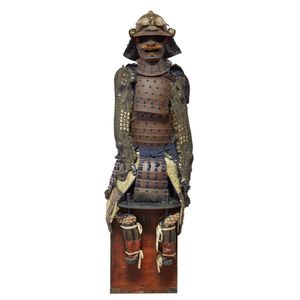Edo Period Samurai Armour with Bat Ornament
You must be a subscriber, and be logged in to view price and dealer details.
Subscribe Now to view actual auction price for this item
When you subscribe, you have the option of setting the currency in which to display prices to $Au, $US, $NZ or Stg.
- Lame in Fabrics - Lamé is a type of fabric that is often used in the production of clothing and accessories to create a metallic or shimmering effect. It is typically made from a combination of metallic threads, such as gold, silver, or copper, and other fibres such as silk, polyester, or nylon. It can be woven or knitted, and is often used to create garments and accessories that are meant to be eye-catching and glamorous. It is commonly used for evening wear, such as dresses, skirts, and blouses, as well as for costume design and stage clothing.
One of the characteristics of lamé is that it can be very lightweight and drapes well, making it a popular choice for flowing and draped garments. It can also be used for accessories such as bags, shoes, and belts, and is often combined with other materials such as leather or suede to create contrasting textures. Lamé can be created in a range of colours and finishes, from bright and bold metallics to more subtle, iridescent effects. Some types of lamé are also available with a patterned or embossed finish, adding an additional layer of texture and interest to the fabric.
While lamé is often associated with formal or evening wear, it can also be used in more casual or everyday garments and accessories, depending on the style and application. However, due to its metallic and often flashy appearance, it is generally considered a statement fabric and is not appropriate for all occasions. - Edo Period, Japan - The Edo period in Japan lasted from 1603 to 1868. During this time, Japan was ruled by the Tokugawa shogunate, a military government led by the Tokugawa family. The Edo period is characterized by a period of relative peace, stability, and economic growth, as well as by the development of a distinctive culture and society.
During the Edo period, the capital of Japan was moved from Kyoto to Edo (modern-day Tokyo), and the country became increasingly isolated from the rest of the world. The shogunate implemented strict policies to maintain control, including the restriction of foreign trade and travel. However, despite this isolation, the Edo period saw significant cultural and artistic development, including the emergence of the ukiyo-e woodblock print tradition, the growth of Kabuki theater, and the flourishing of a vibrant merchant culture.
The Edo period ended with the Meiji Restoration of 1868, which saw the collapse of the shogunate and the restoration of imperial rule.
This item has been included into following indexes:
Visually similar items

An impressive Japanese Edo period Samurai suit of armour, with multi hob-nail plate sujibachi ridged helmet, decorative fukigaeshi (turnbacks), russet lacquered iron menpo (face plate), laced multi-panelled throat guard, shoulderplates, chest guards and le

A finely cast dark bronze alloy Buddha, seated in front of an elaborate aureole with two standing attendants, 19th/20th century, on a stepped throne decorated with Buddhist motifs, height 23 cm, length 29 cm

A 19th century French gilt metal and spelter mantel clock, the gothic base with porcelain panels to the arcaded fascia flanking a white enamel dial with Roman numerals and Breguet type hands, surmounted by a bronzed spelter ecclesiastical figure group. Jap

A 19th century French gilt metal and spelter mantel clock, the gothic base with porcelain panels to the arcaded fascia flanking a white enamel dial with Roman numerals and Breguet type hands, surmounted by a bronzed spelter ecclesiastical figure group. Jap
